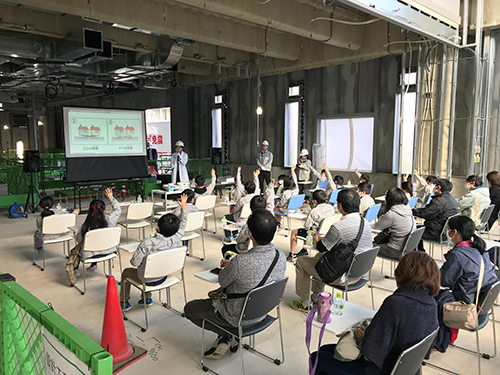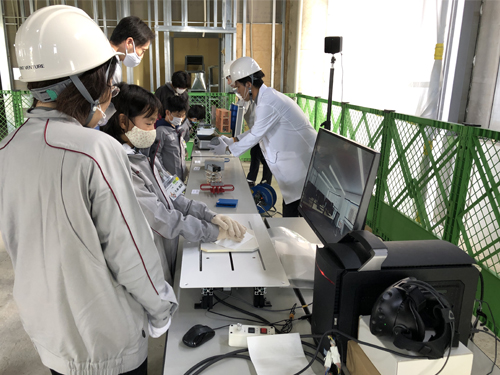Community and social contribution activities
Contents
In order to realize a sustainable society, Takenaka Corporation not only designs and constructs buildings, but also conducts a wide range of activities through architecture, in accordance with our Corporate Code of Conduct. In particular, Takenaka is unique in its efforts to promote architectural culture through mécénat (patronage activities that support the arts and culture), such as the publication of the quarterly magazine approach and the management of Chochikukyo, an Important Cultural Property.
Ⅰ. The significance and thinking behind our CSR, SDGs, and mécénat
Buildings are not only vessels that protect people's lives and properties, but over time, they also influence culture. In order to pass on architectural culture from one generation to the next, we actively disseminate information and contribute to the development of future human resources and the development of local communities. We implement these mécénat activities as an architecture specialist in accordance with our corporate culture and our CSR Vision, and they are also in line with our SDGs.


1. Corporate Code of Conduct
Our Corporate Code of Conduct defines our business, corporate foundations, and our employees' social contribution activities.
Article 7: Actively participate in local communities and contribute to their development as a good corporate citizen, including activities that best utilize the "spirit of craftsmanship, knowledge and technology," which is fostered through our business activities.
7-1 Strive to spread and develop our knowledge and technology through personnel contributions to support academic societies and educational institutions, and by publicizing our works and technologies.
7-2 Communicate with, and maintain and develop good relations with local communities through activities at our workplaces.
7-3 Make efforts to cooperate and collaborate with NPOs and NGOs.
7-4 Promote and disseminate architectural culture, and provide human resources development and research grants through our corporate foundations.
7-5 Support social contribution activities that are conducted by our employees.
Ⅱ. Social contributions
In addition to preserving, publicly showing, and utilizing the Important Cultural Property, Chochikukyo, and publishing approach, we also promote mécénat activities, including the dissemination of architectural culture, in cooperation with three corporate foundations: Takenaka Scholarship Foundation, Takenaka Carpentry Tools Museum, and Gallery A4 (A Quad).
1. Chochikukyo
Chochikukyo (located in Oyamazaki, a town in Otokuni District, Kyoto Prefecture), is a residential masterpiece built in 1928 as the fifth residence of Koji Fujii, an employee of Takenaka Corporation. We acquired the property in 2016, and Chochikukyo was subsequently designated a as an Important Cultural Property of Japan in 2017.
In collaboration and cooperation with the town of Oyamazaki, we worked together with the local community to foster and disseminate architectural culture. Since 2018, with the guidance of the Agency for Cultural Affairs, Kyoto Prefecture, and Oyamazaki, and aided by government subsidies, we began working on disaster recovery and prevention equipment, preservation and repair efforts, and arranging the exterior gardens and other projects. In the spring of 2023, after a series of maintenance tasks, Chochikukyo was at last restored to near original condition. Then in September of the same year, the leisure room and bookstore were opened to the public soon followed by the tearoom, thereby enabling visitors to tour all three buildings and the garden together.

2. Quarterly magazine approach
The quarterly magazine approach was first published in 1964 with the aim of disseminating information on general architecture and culture. The publication’s name reflects the desire of the late architectural historian Teijiro Muramatsu to “encourage the mutual approach and interaction between Takenaka and architecture, cities, and society.”
The magazine’s inaugural opening essay was written by Sawako Agawa, and the late Ikko Tanaka served as its first art director. Visionary content themes helped to keep publication quality high. Some 11,000 copies of each issue are printed and distributed to our customers and the National Diet Library, national research institutes, and universities with architecture and art departments. In 2018, the U.S. Library of Congress acquired a copy before the issue was posted on the public homepage.

3. Corporate foundation activities
In order to expand our social contribution activities more broadly, we have established the following three public interest foundations, each of which conducts various cultural efforts.
・ Takenaka Scholarship Foundation (established in 1961) aims to foster and train people who can contribute to the nation and its culture.
・ Takenaka Carpentry Tools Museum (established in 1984) preserves carpentry tools and passes on carpentry skills.
・ Gallery A4 (A Quad, established in 2005) offers visitors a fun way to experience architectural culture.
4. Takenaka Scholarship Foundation
For more than 60 years since its establishment in 1961, the Takenaka Scholarship Foundation has supported more than 3,600 recipients and sent them out into society. The spirit of the founder, Touemon Takenaka, kanon-hosha (literally “gratitude for kindness”) has been passed along through generations. Many graduates have subsequently joined the volunteer Chikumonkai organization and remain active in the front lines of various social fields.
The activities of the scholarship program include scholarships for undergraduate and graduate students, overseas study support, special support for doctoral students, as well as dormitory management, culture and arts promotion and research grants. Since its advent, the Takenaka Scholarship Foundation has maintained and operated its scholarship program based on a unique system that allows students to continue receiving support from the time of their undergraduate studies through their master's degrees and doctoral programs–irrespective of their field of study–with no repayment obligation.

5. Takenaka Carpentry Tools Museum
The Takenaka Carpentry Tools Museum was established in Nakayamate, Kobe in 1984 as Japan's sole museum of carpentry tools. Its mission is to collect and preserve forgotten and disappearing tools as national heritage items and pass them on to future generations via research and exhibitions. The museum attracts 50,000 visitors annually, many of whom are foreigners interested in traditional Japanese culture. ##
Starting with the preservation of high-quality tools from the days of old, the museum regularly holds various special exhibitions, lectures, seminars, workshops, and other events in order to promote the skills, wisdom, and spirit of the tools’ wielders, as well as the splendid architecture and “wood culture” that has subsequently emerged. We also focus on supporting education and promoting architectural culture by offering hands-on learning opportunities to local children and by accepting trainees from universities.
Overseas exhibitions have received a large number of visitors and have generated a great response. In Japan, we have been holding the waza to kokoro (technique and spirit) seminars, a series of public lectures since 2003. As of end-2023, we held some 104 such seminars for more than 2,000 participants. We will continue to strive to be a place where people can encounter such tools filled with new insights, and to be a source of inspiration for traditional craftsmanship.

6. Gallery A4 (A Quad)
The name for Gallery A4 (pronounced “A-Quad”), which opened in 2005 at our Tokyo Main Office, combines the factors of time, atmosphere and amusement with A3 nomenclature meaning space or architecture. With its “Architecture and Amusement” activity base, the Gallery hosts five to six exhibitions per year. In addition to lectures, dialogs, and workshops with industry experts, the facility also organizes participatory projects such as city walking photo sessions, local events in collaboration with the local Koto Ward, and outreach activities based at the Urabandai Kogen Hotel. Gallery A4 has welcomed over 130,000 visitors since its opening, averaging about 10,000 visitors each year.
We are also increasingly collaborating with external organizations, including those located abroad. In cooperation with the Alvar Aalto Foundation, the Aino and Alvar Aalto – Shared Visions exhibition was held in 2019 to commemorate the 100th anniversary of the establishment of diplomatic relations between Japan and Finland. In 2021, a traveling version of the exhibition with expanded content was held at public museums. In 2022, the Western Art Foundation gave Aino and Alvar Aalto its Cultural Promotion Award. By taking a broader view of architectural culture, including design and technology, nature and the environment, lifestyles, education, science, history, and urban creation, we aim to deepen the affinity between architecture and people's everyday issues and contribute to the fostering of a more affluent society with a view toward the future.

7. Recognition of mécénat activities
Corporate mécénat is being pursued more actively than ever before as part of corporate social responsibility (CSR) efforts, and their scope is expanding to help resolve social issues. In response, the movement to encourage mécénat by recognizing them is becoming stronger. This includes the Japan Mécénat Award, which is sponsored by the Association for Corporate Support of the Arts.
Our efforts to disseminate architectural culture have been highly acclaimed. The Takenaka Carpentry Tools Museum received the Japan Mécénat Award in 2008. Gallery A4 received both the same award in 2014 as well as the Mécénat Award for Excellence in 2022. approach magazine received the Architectural Culture Approach Award in 2016, and Chochikukyo received the Grand Mécénat Award in 2019.
When Chochikukyo received the Grand Mécénat Award, an award jury member commented, “It struck me that you executed with this project while knowing that it would also make Takenaka a better company. It is true that the culture of Takenaka Corporation's emanates from within, and I believe that your company confirms its identity through these kinds of activities. In fact, I believe that future mécénat activities will be impossible without invigorating your own company and fostering our own corporate culture.” We are also actively involved in the “This is MECENAT” certification system.
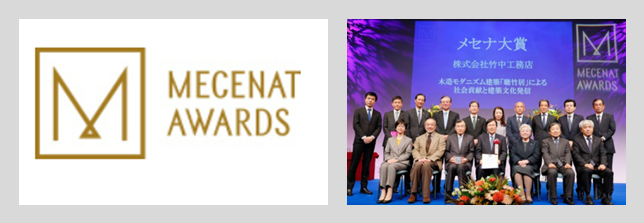

Ⅲ. Contribution to local communities
Takenaka Corporation promotes community contribution activities with the aim of learning about local issues and needs by communicating with local municipalities, schools, NPOs and other stakeholders. We also contribute to developing local communities and to the nurturing of the next generation of human resources by utilizing the “craftsman’s spirit, knowledge, and skills,” which have been cultivated through our own businesses. Specifically, we develop human resources for academic and educational institutions, disseminate and development knowledge and technology through in-house learning programs, conduct community exchanges at each business location, and cooperate with corporate foundations.
1. In-house awards for contributions to the environment, local communities and society
Every June is designated as Takenaka Group Environment Month, a time when we conduct activities that include hosting a biodiversity symposium and displaying awareness posters. We also present the Environmental and Social Contribution Awards and Social Contribution Award for activities that have helped local communities. Takenaka’s President also bestows the Award for Excellence in Social Contribution Activities which recognizes efforts that have passed a rigorous screening process conducted by the company and by Takenaka Group executives.
After receiving their certificates and prizes, award winners introduce the activities that led to their selection. The ceremony is broadcast to all company employees in real time over the Internet in order to further educate them about regional and social contribution efforts.
Applications and awards are open to all group companies.
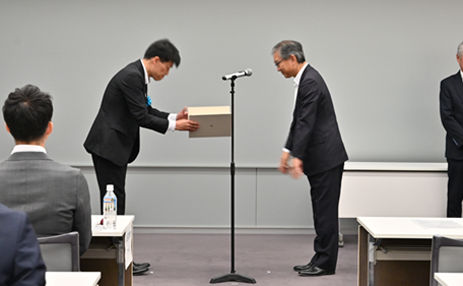
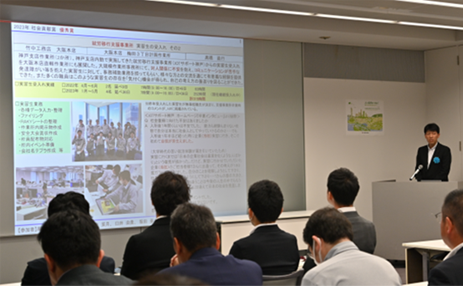
2. Compiling examples of community contribution activities
To augment interest among employee and Group companies to make community contributions, we have created a system that allows workers to easily submit examples of their efforts and to view those of others. This system is currently up and running at Takenaka Corporation (in limited form). In addition, employees are reminded about this campaign once every quarter in order to encourage them to participate. About 300 submissions are registered every year.

3. Introducing examples of community contribution activities
The following is a partial list of community contribution activities that have been published as part of our internal PR activities. They are published to facilitate internal sharing.
Participating in the Sapporo Snow Festival for the first time in three years
The Sapporo Snow Festival, a winter tradition in Sapporo, Hokkaido, was held at Odori Park from February 4 to 11, 2023, with our Hokkaido Branch participating as part of its social contribution activities. The festival had been held virtually (via the Internet) for the prior two years due to the coronavirus pandemic. Entitled Snow Bamboo 2023, three characters were recreated from the popular Pocket Monster (Pokemon) anime series. Snow Bamboo sculptures attracted much attention, and several media companies also covered the event. Branch volunteers participated with their children, commenting that it was a memorable activity.
Citizens' snow sculptures were displayed at Odori Nishi 3-Chome and 9-Chome locations, where 60 of them were lined up for photographing by tourists from all over the world. We are pleased that our local branch was able to contribute to the festival, which showed renewed vitality.
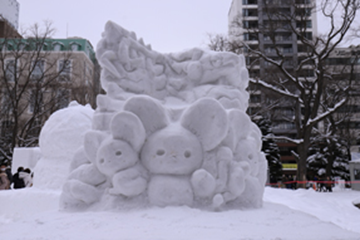
Teachers and students tour of Nagoya Castle maintenance project workshop
On December 2, 2022, some 17 teachers and students from Nagoya University, Nagoya Institute of Technology, and Hiroshima University toured the Nagoya Castle Maintenance Project work site. The tour was requested by Nagoya University, which commissioned Professor Emeritus Yasutoshi Sasaki and Professor Mariko Yamazaki to conduct structural performance tests on the timber used in the reconstruction of Nagoya Castle. Yasunori Kawasaki, a member of our sales department, and teachers and students belonging to the Wood Urban Design Project, in which Mr. Kawasaki participated, also took part. After an opening speech by work center head Naoyuki Kuze, rebuilding effort leaders Mitsuhiro Jokaku and Misako Inoue gave an overview of the castle tower’s timber construction, introducing the electronic management and BIM technology used for timber inspection and storage. Participants were able to hold a model made by 3D printer. “I was very impressed by your company’s message and efforts to connect traditional technology to the future,” Professor Yamazaki commented after the session.
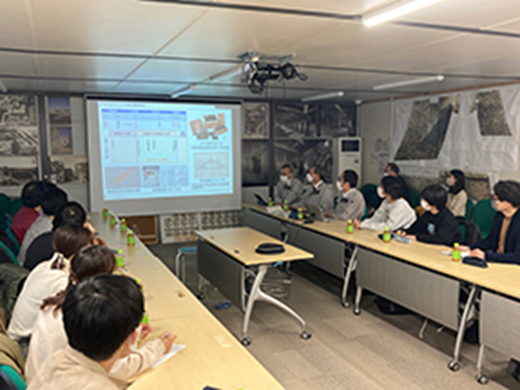
Participating in the 16th Koto Ward Environmental Fair
On June 4, 2023, Tokyo’s Koto Ward and the Koto Ward Environmental Fair Executive Committee held the 16th Koto Ward Environmental Fair at the Eco-Kuru Koto Environmental Learning Information Center, under the theme “Let's Act! Reduce CO2 emissions,” we once again participated this year.
As timber use is linked to the revitalization of forests and the reduction of CO₂ emissions, we held a kumiko coaster making workshop using at our booth. A traditional woodworking technique involving precision-engineered wooden components, kumiko is assembled into geometric patterns without using nails. The Takenaka Carpentry Tools Museum provided the kumiko kits. Some 100 people visited our booth on the day of the event under bright, post-typhoon sunshine. Forty-nine people tried the kumiko puzzle, enlisting the help of their families, friends, and our staff while referring to the assembly instructions. Participants were pleased to hear comments such as, “The precision of the wood machining is amazing,” and, “I came to the fair because I wanted to do this.”
At our booth, we also used posters to introduce timber and our timber construction initiatives. Proceeds from the workshop will be donated to the National Land Afforestation Promotion Organization (NLAPO)’s Green Fund, which aims to promote healthy Japanese forests. June is Environment Month at Takenaka, a time when the entire Group engages in activities that contribute to the environment in cooperation with local communities.
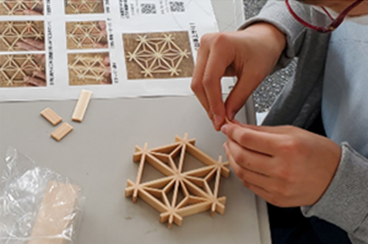

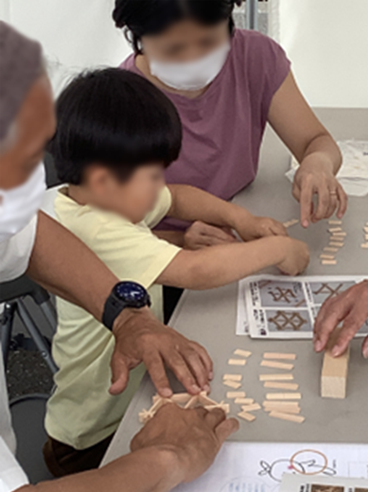
Our Tohoku Branch displays “Future Town” models designed by children
For three weeks, from July 13 to August 5, 2022, the Jozenji Gallery on the first floor of the Sendai Jozenji Building (where our Tohoku Branch is located), hosted an exhibition entitled, “Dreams come true: Creating towns of the future–‘Future Town,’ as conceived by the children of Shichigo Elementary School.” As part of our reconstruction and community-building learning program, we have supported “Creating the Future Shichigo Town,” a program that has been offered since 2012 to Shichigo Elementary School 6th graders in Sendai, Miyagi Prefecture as part of their normal curriculum.
Children's vision of the city of the future
This year, the second phase of the nine-year “Creating the Future Shichigo Town” project was scaled around the former tsunami-damaged Arahama Elementary School, and model of the future town of Arahama was proposed. With 11 years having passed since disaster struck the region, affected areas are now in the final stages of reconstruction. At the same time, teaching and transferring the lessons of the disaster to children who were too young to have directly experienced the quake disaster remains as an emerging issue. We will continue our efforts to nurture the next generation of leaders and develop the region through community development.
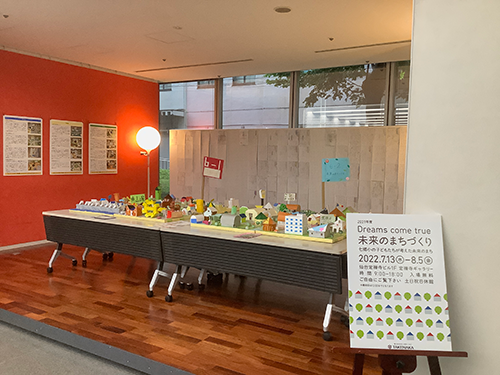
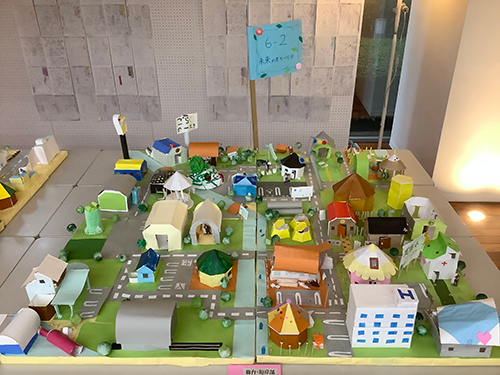
Building Exploration Team, a hands-on program for children
On October 24, 2020, a Takenaka Kids Program, “Building Exploration Team” was held at the construction site of a new government building in Yonezawa City, Yamagata Prefecture. The program invited local elementary school students to see, touch and feel the technologies and approaches that characterized the buildings that Takenaka has constructed. The project has been held at landmark buildings and environmentally friendly wooden housing complexes. Some 70 third and four grade children participated with their parents. Using quizzes, models, and a hands-on feel of seismic isolation equipment, the program taught children about the latest technologies that were being employed to protect buildings from earthquakes–typically a prime feature of the event’s host building.
In a post-program questionnaire, we received comments such as, “I learned for the first time about the ingenuity that goes into buildings,” and “I’d like to come back and compare (the building) to the time when it was under construction,” showing that many children likely had become interested in architecture. We will continue to convey the appeal of architecture to the local community, including children, and to contribute to developing human resources for the next generation.
